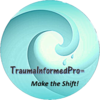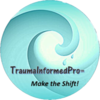Those of us who ‘get’ the trauma-informed movement understand how to put the dots together when we’re interviewing a new client. Our ear hears the pertinent details: the ACES, the Big Ts, the little ts and all the complexities as they tell us their story. We sit, knowing the many tools we can offer to help this hurting person cope, heal and recover. We validate, affirm and offer hope for a better future. We know we can help. We have gold to give them.
But, not all who have suffered what we would identify as “trauma” are able to hear that word. It scares them, it immediately triggers their need to minimize, in defense, what they have experienced. If that new client has not specifically sought out a “trauma-informed” practitioner, he or she may even be put off by our well-meaning compassion. It doesn’t matter whether their life experiences qualify as big, little, complex or otherwise traumatic. Often, what clients present to us has become their norm—yet here they are in our offices, asking for help.
How do we support our new client without sending her or him running out our doors?
The Seeking Safety curriculum puts forth the idea of using themes (“accessible language that avoids jargon"). Furthermore, the use of “humanistic themes” can serve to, “… restore patients' feeling of potential for a better future. The title of each session is framed as a positive ideal, one that is the opposite of the pathological characteristic of PTSD and substance abuse.” (Implementing Seeking Safety therapy for PTSD and substance abuse: Clinical Guidelines Lisa M. Najavits, PhD)
Speaking from general themes of human experience can help the new client absorb what is being said without feeling singled out. Many survivors of trauma have grown up believing they are crazy, messed up or just plain different from everyone else. They may have been labeled “bi-polar”, “conduct disordered” or “hyperactive”. Using themes helps them see themselves as having a more common life experience and this can help them peek out over their defensive “I’m fine” armor.
You’re sitting across from a new client. She’s quietly waiting for you to look at her file. She has been a patient of one of the doctors in your agency; she was referred to you for ongoing depression, anxiety, disordered eating patterns, abuse of alcohol and suicide attempts. You begin to ask all the usual questions. She answers with elaboration about her family. She grew up with her biological parents, but they divorced when she was 9. Her father remarried and moved away. Her mother had several relationships, often with men who abused alcohol; she remarried recently. Your client is now a student in a local university—she was originally referred to the agency due to being on the brink of academic probation. She has previously gained a 3.8 GPA but it has been falling.
In private practice I have the luxury of being my own authority. I can speak the language that I know can lead to helping my clients gain their best life. I can speak about injury model versus sickness model, I can describe the compassionate versus non-compassionate use of the medical model. In short, I can “traumaspeak”. But, not everyone who may benefit from our trauma-informed thinking—our gold—may recognize that what we offer is valuable. How I approach her can determine if my client benefits from all the knowledge, experience and tools I have to offer or if she leaves feeling poor--unheard and unhelped.
I start explaining that I use a “trauma-informed” approach. I watch for her reaction to that. She seems to tense up and relax a bit, at the same time. I smile and say, “I know, it sounds a bit scary, to call your experiences ‘trauma’, doesn’t it?” She nervously smiles, nodding her head. At this point I may share brief, general information about ACEs or I might reassure her with a discussion of what she can expect as we embark on her work together. I use the terms “we” and “humans”, often. I emphasize that her safety and healing is most important, not blame and shame of persons who may have hurt her in the past.
If she is responding positively to my traumaspeak, I offer validation of her experiences and bolster confidence in her ability to stay functional as she builds effective coping skills for the symptoms she has shared. I emphasize her strengths and point out that most people can find relief from depression, anxiety and traumatic responses as they feel supported and learn that they are not crazy at all, but have experienced reasonable responses to unreasonable circumstances and events.
This is just one scenario. What’s important to remember is this: many people who have experienced multiple traumatic events and circumstances are not ready to hear the word “trauma”. It won’t matter how many evidence-based models we are trained for or how passionate we are about our “trauma-informed” way of thinking—if we don’t establish rapport and respect for the client’s defenses, we may not have a second chance to meet him/her where he/she is.
The first defense for surviving trauma is to deny the fact of trauma, especially when this starts in childhood. The armor that has built up may be quite impenetrable and it will take patience and skill to gently open that protective covering. Whether we are working as a psychotherapist, case-manager, rehabilitation counselor, addictions counselor, doctor, nurse or any other direct-care personnel, the way we present our gold will determine whether our client will gain the riches of recovery and life beyond trauma.
Our understanding of other major defenses or trauma responses will greatly determine if our client reaches out to take the treasures we have to offer. Next, we’ll discuss two primary coping defenses that can impede or support our client’s progress and our ability to help them go for the gold.







Comments (14)